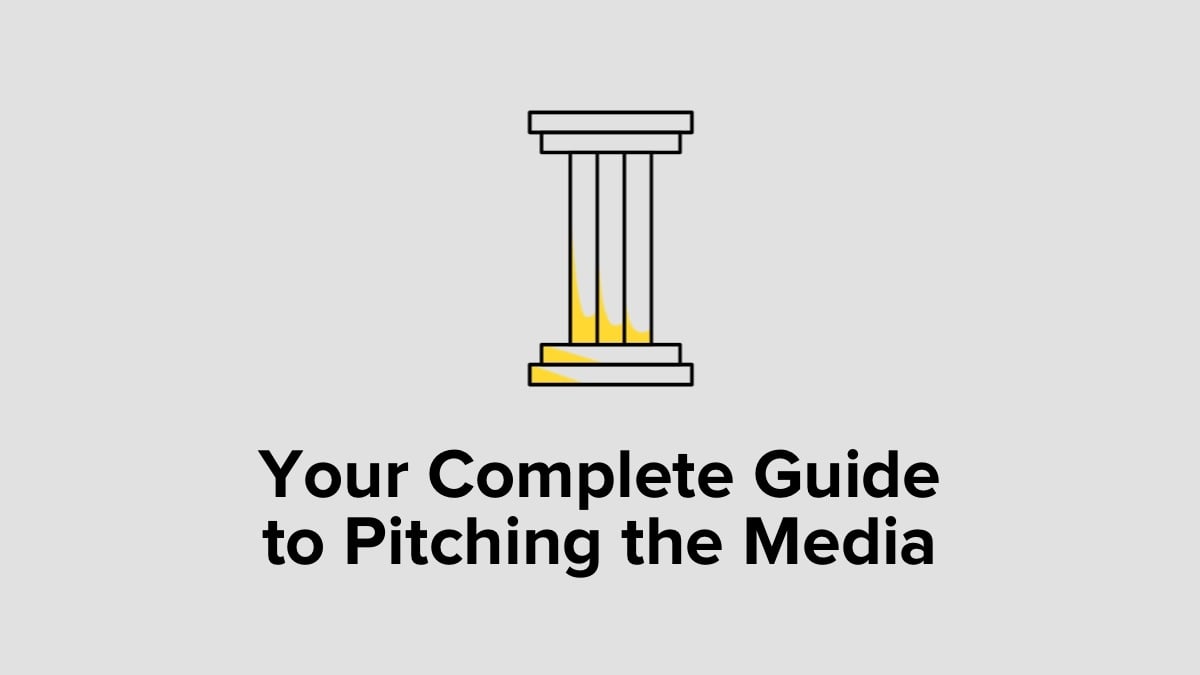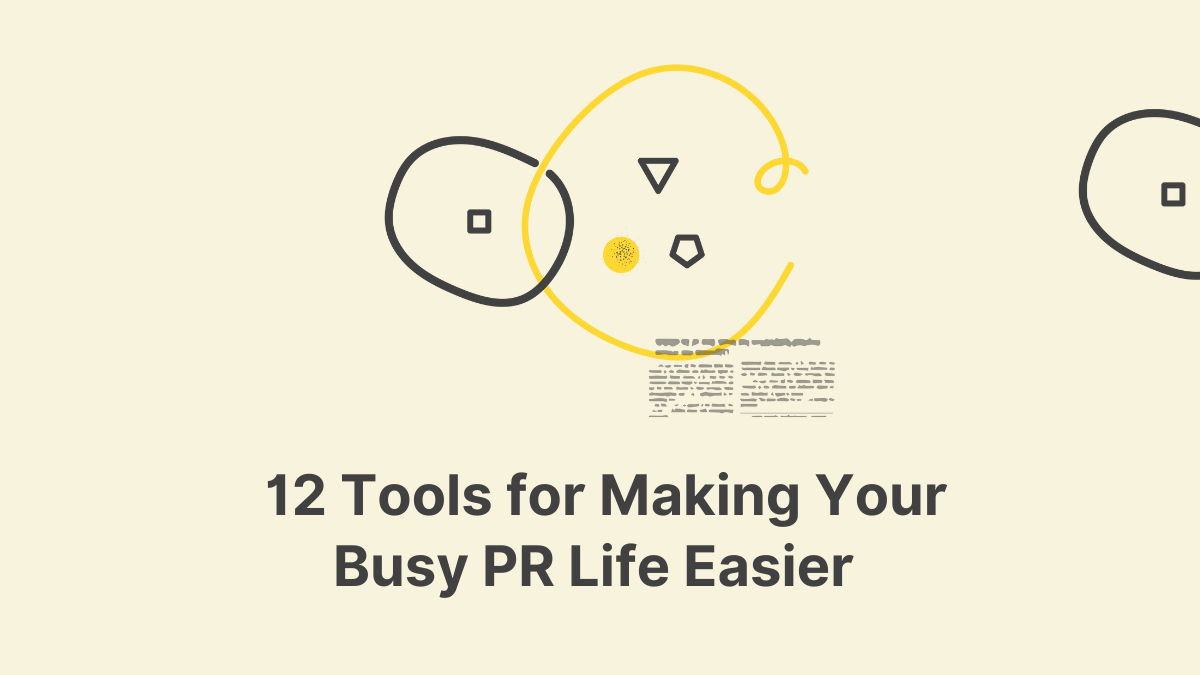Your Complete Guide to Pitching the Media
Stuck pitching journalists and receiving no responses?
Spending hours researching who to pitch your news to?
Struggling with what to include in your pitch?
We get it, pitching journalists is no easy feat. Finding who to pitch your news to, how to write it, and praying you land coverage is stressful.
According to Fractl, “Just over 42% of writers reported receiving 11 to 100 pitches a day.” This proves just how much competition there is within journalists’ inboxes and how important it is to create a pitch that’s relevant, succinct, and clear.
It takes a lot of time to research journalists and create a pitch that converts, but there are ways to make this process more streamlined and less ominous. Whether you are looking to figure out if you should include a press release, how to follow-up to a no response, or just simply want to see what successful pitches look like, we’ve got you covered.
This post serves as a guide to streamline your pitching process from ideation to creation. It provides you with actionable takeaways that you can immediately implement in your next pitch in order to execute your pitching goals.
Media Pitch v. Press Release
We’ve all heard the words “pitch” and “press release,” but what’s the actual difference between the two? And more so, when do you use one over the other?
PR consultant, Michelle Garrett, explains the difference between these two:
It depends on the goals. Press releases serve a purpose beyond media relations, IMO - they help get everyone on same page re: messaging, can be posted on your site to show history, etc. A pitch feels less formal, but in some cases, it's all you need. Sometimes both are warranted.
— Michelle Garrett (@PRisUs) September 15, 2020
A press releases “...serve a purpose beyond media relations, IMO - they help get everyone on same page re: messaging, can be posted on your site to show history, etc.”
A media pitch “...feels less formal, but in some cases, it's all you need. Sometimes both are warranted.”
It’s important to recognize what works best for what you are trying to accomplish. If you are trying to get information out and to the public without much customization or personalization, a press release might be a better fit than a pitch. It is straightforward and provides everyone with the information you are sharing.
However, a pitch has the ability to be personalized and tailored to the journalist you are trying to get to cover your news. It has the inherent ability to stand out in a journalists inbox merely because it is not a “blast email.”
Here are three things to consider when deciding to use a press release or pitch:
1.) What’s your ultimate end goal? Media coverage or mass distribution of information about your brand/client?
2.) Would a blend of the two be beneficial to your end goal?
3.) What journalists are you approaching with this news and are they the best fit for receiving a press release or a pitch?
As you’ve seen in our guide to media relations taking the time to research what a journalist covers and making sure your story is a good fit is the key to establishing a solid relationship with any reporter. The “pre” pitch work is just as important as the pitch itself, but when both sync and align, the outcome is bound to be a positive one.
Three Techniques To Discover The Right Journalists For Your Stories
Pitching is only part of the equation. Before you can pitch a journalist, you must first discover and determine the right journalists to pitch. Time is precious for both you and the journalist. That’s why it’s important to optimize your pitching efforts upfront with these three techniques to find journalists.
Three key techniques to keep in mind:
Search Smarter
Though national coverage is very desirable, don’t underestimate the power of local journalists. Oftentimes, their reach and credibility within specific areas and fields are just as valuable. Don’t be afraid to research more specific newsletters or regional publications. Also, look to social media to see what journalists are working on or interested in. A study also shows that 74% of journalists use Twitter to research a story they are working on.
Consider Your Target Audience
Don’t get so swept up in finding the right journalists that you forget about your audience in the end. Understanding the end reader is extremely helpful in narrowing your search for journalists who will fit the task. The more complete your understanding of the audience is, the more tailored your pitch can be toward the journalist who writes specifically for them.
Use Technology to Remove the Guesswork
Work smarter not harder. There are loads of tools out there to streamline your process. That’s the entire philosophy behind OnePitch Scores. Using tech tools can automatically narrow your efforts and save you time. With OnePitch scores, give us your pitch and we’ll do the discovery for you.
One key thing to not forget in this process is that pitching is more than a transactional effort. Part of searching for journalists to pitch is discovering and fostering relationships along the way. Read more about that in our blog on media relations vs public relations.
5 Elements every Media Pitch Should Include
Journalists are busy people. Like PR pros, they work in a fast-paced environment where they are constantly juggling many different stories and tasks. Inundated with tens if not hundreds of pitches each day, it is important to understand that you are completing for their attention. A well-crafted pitch takes that into account, delivering your message in the most effective way to get their attention and garner their interest.
So what exactly makes a pitch effective?
Here are 5 elements that make a strong pitch:
Element 1: Intention
No one wants to waste his or her time. Your intentions must be clear as they will guide your pitch in establishing what it will consist of. Be sharp in identifying what you are trying to achieve and how working with a specific journalist will help you accomplish it. Clear intentions help you expedite communication and save both you and the journalist time.
Element 2: Trend Relevancy
What does this story offer to its audience? Understanding your story’s relevancy comes from keeping up with the world around you and finding your place in it. Be able to use your “peg” in both the subject line and body of your pitch to build interest that sets your pitch apart from others. Figure out and clearly describe the urgency of why your viewpoint on a subject is important for being covered right now.
Element 3: Value
Every journalist loves a clear and concise pitch that cuts through the fluff and delivers value upfront. Having an elevator-pitch explanation of your story allows you to get their interest without needing to over-explain. Additions such as data and brief evidence help you establish credibility and add to your message quickly.
Element 4: Personalization
Not all journalists are alike, therefore your pitch must not be either. It may seem obvious, but identifying the industry and niche of your story will help you identify exactly who should be telling it. Familiarizing yourself with what they create helps you better understand how to present your pitch in a way that they easily find attractive. The more in-tune your pitch is to its recipient, the more likely you are to receive a response.
Element 5: Contact Info
This last element, though essential and obvious, is often overlooked. Be sure that the journalist knows how to contact you beyond just your email. Streamlining this information allows them to not have to jump through the additional hurdle of finding you later. Again, it is all about making it as easy as possible for a journalist to pick up your pitch.
Your pitch not only represents the story you have to tell but also who you are as a story advocate for your client. Be sure that your pitch best represents your client and you as a PR pro to the best of your ability. Though not absolute, these 5 elements serve to ensure that your pitch is more than just run-of-the-mill.
6 Examples of Successful Media Pitches
We’ve spoken about successful pitches before in our PR 101: The Ultimate Guide to Pitching eBook. One narrative we have consistently mentioned is there is no one-size-fits-all approach to pitching journalists. If you’re pitching a B2B writer from a top-tier publication you wouldn’t want to position your pitch the same way as a B2B writer from a trade publication. Similarly, you wouldn’t pitch a consumer product to a writer who is covering news about businesses.
With the ever-growing news cycle and the increasing popularity of news-focused stories, it’s more difficult than ever to reach journalists with a pitch that fits their needs. Below we’ll outline the key factors from 6 of the top-performing pitches submitted through OnePitch. Not only did these pitches get connected with journalists but they were also were perfectly tailored to what they write about by using specific tactics to make them stand out.
Here's what made these 6 top pitches stand out:
Example 1: Strong Subject Line
Subject lines are the first thing a journalist sees in their inbox and make or break your chances of being opened let alone considered. Keep them specific and summarize what you’re about to share in your email.
Example 2: A Clear "What"
Having a clear “what” regarding your pitch helps journalists know exactly what you’re sharing with them. No need for fluffy language or long, creative sentences here.
Example 3: Timeliness
One important component of relevance is timeliness. Think about how you can pitch news BEFORE it’s going to break or, in this case, before a major holiday.
Example 4: Strong Supporting Data
Using data to support your cause is a must in today’s landscape. It’s an added bonus if you can present the data in a way that grabs the attention of journalists and makes it easy for them to include in their article.
Example 5: Including Specific Links
We always recommend including specific links within a pitch that lead the journalist to a page that explains more about what they’re reading. The homepage is a start but if have a landing page or webpage explaining more then include this instead.
Example 6: Added Media
When is the last time you read an article that had no media components (e.g. pictures, video, audio)? Chances are it wasn’t recently and now more than ever readers need additional forms of media to retain their attention.
While there are very specific elements each pitch should include, the examples above outline WHY they hit the mark and grabbed the attention of journalists. Another useful resource we compiled outlines How to Land Coverage in Top Tier Publications where we asked this pro for her advice and experiences on the subject.
How to Send a Follow-Up to a Media Pitch
Many blogs and articles about media pitching focus on what to do before and while you are constructing a pitch. Still, one key aspect of media pitching is what you do after the initial pitch is sent. Here comes the follow-up. Follow-up emails are the third part of your pitching process that can make or break all of your previous efforts.
Why is the follow-up so important? As you are not the only person in a journalist’s inbox, a polite and professional follow-up can be an appropriate reminder of the great story you have to offer. Given that, what is the appropriate amount of time to wait before following up? Though journalists all operate differently, a general consensus has been to wait about three days to a week before sending that follow-up email. From knowing how crazy journalists’ inboxes can be every day, allowing the journalist a reasonable amount to respond is a sign of understanding their side of this mutually beneficial interaction. It is important to walk the fine line between being diligent and being pushy.
Again, the follow-up email is meant to show the value you bring to the journalist. Just like the pitch, your follow-up email needs to be easily digestible and appealing to your specific audience.
When constructing your follow-up email, here are a few things you should consider:
1.) Pay attention to your subject line
2.) Be concise and courteous
3.) Avoid spam trigger words
Public Relations professionals shape the message they want to convey and Media Relations helps to give them the voice and amplification they need to get their story out there.
The takeaway: media relations is the foundation of all public relations. To find success, both have to be built and work simultaneously.
Even after your diligent efforts, you may still be left with no response. A nonresponse can mean many things from the journalist not being interested to simply that your pitch got lost in a flood of incoming emails. This is where a well-crafted and thoughtful follow-up email can serve as your additional attempt to clarify the silence. Most often, if a journalist is interested, your follow-up email will serve as a courteous reminder rather than a deterrent.
Though a follow-up email is a last-ditch effort to inquire about their interest, it is important to not let a nonresponse get the best of you. Just as being diligent in your pitching process is crucial, it is also paramount to not let small moments like this impact your future efforts. The pitching process is a constant learning experience. Every new pitch, response or not, is a great opportunity to better your skills that will pay off in the long run.
_______
In the end, we understand how daunting, time-consuming, and frustrating pitching can be. Whether it is the right pitch but the wrong time, or vice versa, PR professionals understand that it is all about trying to make the most of an opportunity. Don’t forget, pitching is not a one-and-done process. Each pitch you send is an opportunity to build media relationships. Not sure how media relations fit in your work? Check out our media relation guide to learn about this key but overlooked aspect of being a PR professional.
If you have ever been curious about how journalists perceive pitches, be sure to subscribe to our podcast, Coffee with a Journalist. Each week, we sit down with journalists from your favorite outlets to discuss what pitches they respond best to, how they craft their stories, and much more! To start, check out our conversation with John Biggs, Editor in Chief at Gizmodo, where he discusses his past as a founding editor at TechCrunch, the changes in his pitch preferences, and his views on where journalism is heading.
Want more blogs like this?
Fill out the form below to subscribe to our newsletter and receive emails with the top blogs from The TypeBar!
OnePitch
OnePitch is a platform that connects public relations professionals with journalists, streamlining the process of pitching stories. Designed to simplify media outreach, OnePitch helps PR experts craft pitches that resonate with journalists, increasing the chances of coverage. By fostering meaningful connections between PR professionals and media outlets, OnePitch enhances the storytelling process, making it easier to share newsworthy content with the right audience.
Related Posts
When pitching to journalists, understanding their preferences is key to getting your story noticed....
PR professionals juggle multiple responsibilities—crafting pitches, monitoring media coverage, and...
Newsletter Form
Recent Posts
About Us
OnePitch was created by a handful of
tech-savvy publicists and journalists
who believe that the PR industry is
long overdue for some innovation.
We’re changing this with OnePitch.





